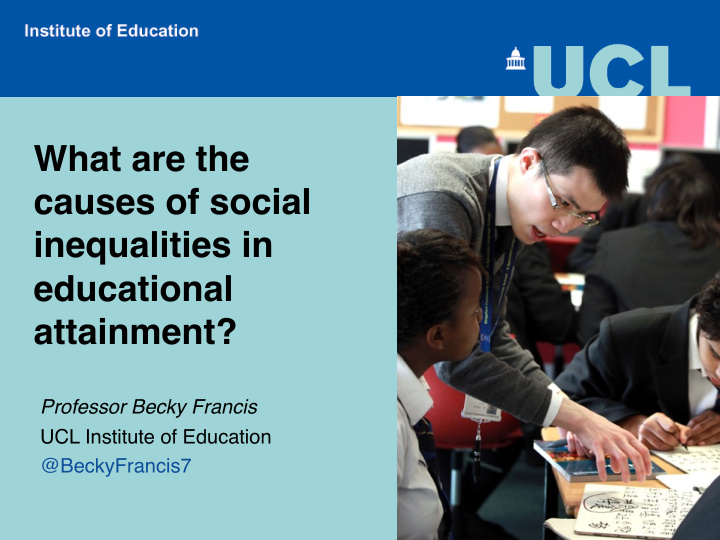



What are the causes of social inequalities in educational attainment? Professor Becky Francis UCL Institute of Education @BeckyFrancis7
Aims: • To briefly explore the current picture in terms of identity, family background, and educational attainment, with a focus on socio-economic background • To explore explanations for the socio-economic gap for attainment • To introduce the EEF-funded ‘Best Practice in Grouping Students’ project
Gender: Percentage of girls and boys attaining 5 A*-C incl E&M at GCSE 2011 2015 Girls 61.9 61.8 Boys 54.6 52.5 Gap 7.3 9.3 source: DfE
Ethnicity: Percentage gaining 5 A*-C incl E&M at GCSE, 2015 90 80 70 60 50 40 30 20 10 0 source: DfE
Percentage gaining 5 A*-C incl E&M, 2015 Girls Boys Non-FSM 65.8 56.2 FSM 37.2 29.3 source: DfE
Attainment gaps between FSM-eligible children and non-eligible children (From Lupton & Thomson, 2015, London Review of Education ) 30 27.6 27 25 Percentage points 20 21.3 18.1 15 10 2006 2007 2008 2009 2010 2011 2012 2013 2014 KS2 5A*-C incl. English and Maths
Clifton & Cook (2012) A Long Division (IPPR)
What explains the gap? • Financial capital • Social and cultural capital, and (overlapping with) social identities • Practices of schooling
Waldfogel and Washbrook, 2010
• Disadvantaged pupils are concentrated in poorer quality schools • Disadvantaged pupils are under-represented at high- attaining schools • Disadvantaged pupils are concentrated in lower streams and sets (wherein less progress) • Disadvantaged families are less able to purchase and/or draw in support • Disadvantaged pupils may be disengaged from schooling • Disadvantaged pupils are less likely to pursue subjects that enable progression routes to high-status careers
‘Best Practice in Grouping Students’ https://educationendowmentfoundation.org.uk/evaluation/projects/bes t-practice-in-grouping-students/ https://www.ucl.ac.uk/silva/ioe/departments- centres/centres/groupingstudents
What does the international research say? • Disadvantaged pupils are disproportionately concentrated in low sets and streams • Pupils in low sets and streams have poorer outcomes • And…
Explanations for poor outcomes • Teacher expectations and related pedagogy • Impoverished curricula and qualifications • Quality of teaching • Misallocation • Lack of fluidity • Student engagement and attitudes • Self-fulfilling prophecy
What we don’t know 1. What is the impact on achievement for pupils in low sets if detrimental practices are addressed? 2. What actually constitutes excellence in mixed attainment (‘mixed ability’) grouping? 3. Which of these good practice alternatives is more effective?
The interventions • Best Practice in Setting • Best Practice in Mixed Attainment • Each includes • Organisational elements • CPD to address specific issues
Students’ perceptions • It affects us because it makes you feel either you are cleverer or have better abilities, or not very good abilities… (James, Year 7) • You just feel so dumb, you just feel lazy: ‘I can’t be bothered to do anything, because… there’s no point of me doing any work, because I don’t achieve anything in my life.’ (Tanvi, Year 7) Student names are pseudonyms
Figure 1. Adjusted Mean Scores for Self-Confidence in Maths and English by Perceived Set Allocation* 31.00 29.33 Maths English 29.00 28.28 27.00 26.52 26.13 25.77 25.45 25.00 23.00 21.00 Top Sets Middle Sets Bottom Sets *Estimated using multilevel model (students within classes within schools) and controlling for ethnic group, family occupational background and number of set levels within school
Figure 2. Adjusted Mean Scores for General Self-Confidence by Perceived Set Allocation in English and Maths* 31.00 Maths English 29.00 27.00 26.18 26.15 25.22 25.20 25.00 24.45 24.18 23.00 21.00 Top Sets Middle Sets Bottom Sets *Estimated using multilevel model (students within classes within schools) and controlling for ethnic group, family occupational background and number of set levels within school
It’s been suggested that the set they’re put in affects the way kids think about their abilities, and even whether they enjoy school. What do you think about that? Yes, definitely. We can try to hide it, but it is blatantly saying, “You are less intelligent than this person.” So, I think some people definitely feel a bit miffed about that. (Fred, Set 1 maths & English) Definitely, because it makes you think why… it makes me think, “Why can’t I be taught with everyone else who’s in the top group?” And then I try my best and I do try my best. Even though it’s my best and I get put low – not low – but in a different group than the high group, so it feels like if that’s my best and this is all I can do, what can I do? (Martina, Set 3 maths and English)
Recommendations for policy • Continue to fund the Pupil Premium, but need to better support and guide schools in productive investment • Continue to support White Paper impetus for spreading capacity and excellence across the system • Avoid further social segregation (whether within or between school), which the OECD shows to be detrimental to outcomes • Find ways to crack the challenge of engaging parents • Continue to support and enact evidence based practice • Find ways to support and educate teachers (including through ITE) on the impact of social identities and social capitals in ways that avoid stereotyping
Recommend
More recommend